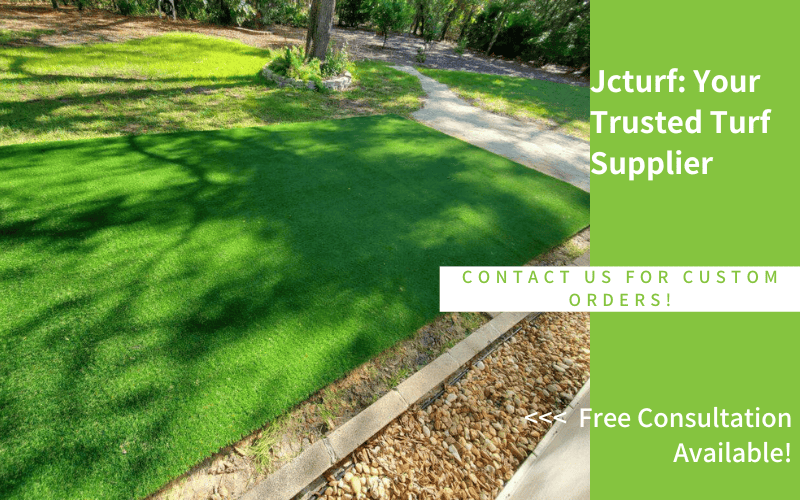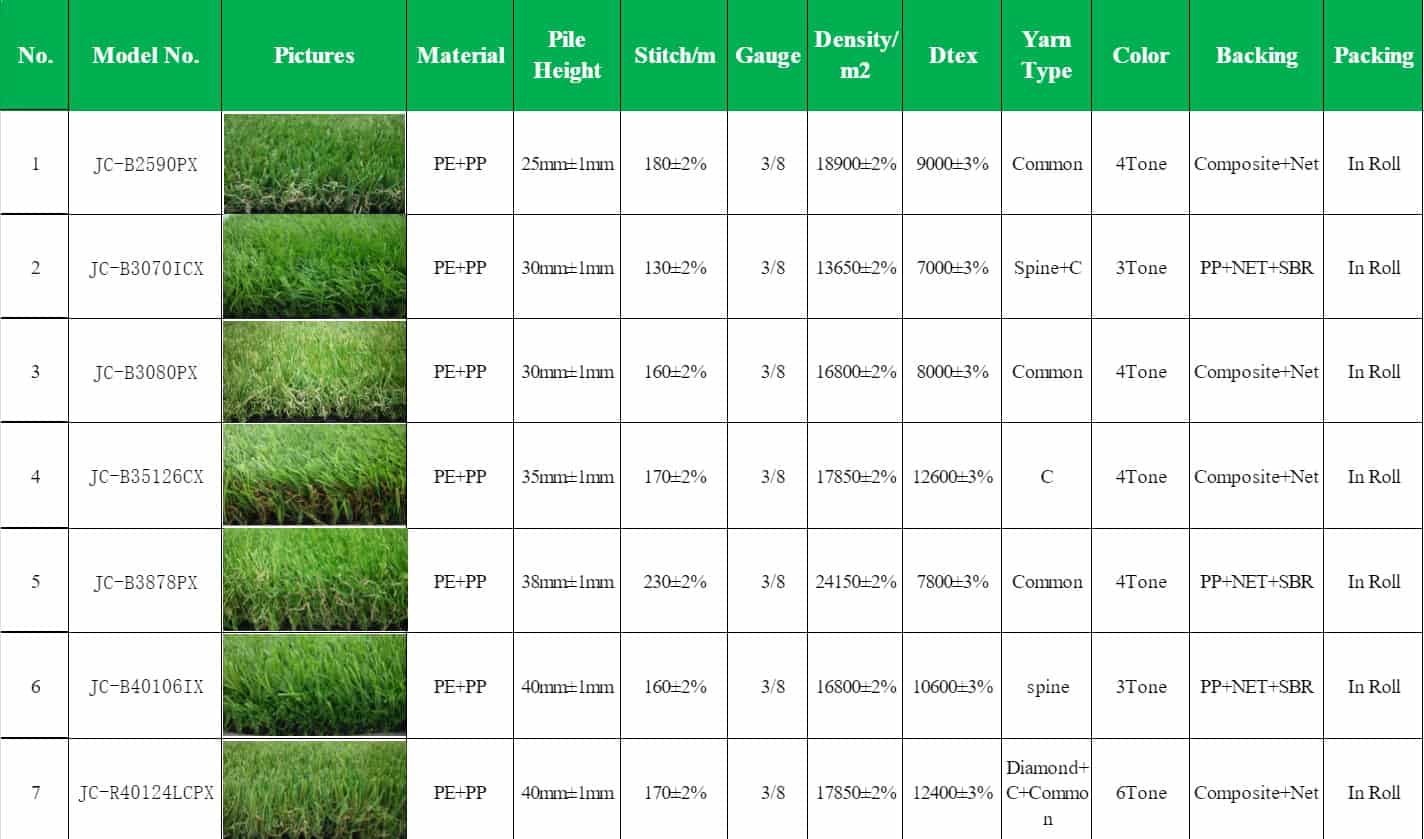Yes, you can lay artificial grass next to real grass—and when done right, the result can be both practical and visually seamless. But it takes more than just placing the two side by side.
In this guide, we’ll cover everything you need to know: essential site checks before combining the surfaces, step-by-step installation instructions, why laying turf directly on live grass isn’t ideal, creative design ideas for smooth transitions, common mistakes to avoid, and how artificial turf might affect the real lawn nearby. Let’s make sure your mixed grass setup looks great and performs even better.
Can You Put Artificial Grass Next to Real Grass?
Yes, you can place artificial grass right next to real grass — and it works well when done correctly. The key is to separate the two surfaces with a clear edge and ensure both areas are properly prepared. Without this, you may end up with uneven ground, drainage issues, or an unnatural look.
Many homeowners and landscapers use this method to combine the lush look of natural grass with the durability and low maintenance of artificial turf. It’s a smart way to handle shady zones, high-traffic paths, or spots where natural grass struggles to grow. You still keep the organic beauty of real grass while solving practical problems in targeted areas.
However, it’s important to plan the transition line carefully. The artificial turf must be installed on a compacted base, not loose soil, and should not directly touch the real grass without a defined border. Done right, this mix can give you a clean, attractive lawn that performs better than grass alone.
Key Considerations Before Combining Artificial and Real Grass
Before you combine artificial grass with real grass, it’s essential to review a few key setup conditions. Things like drainage, surface height, root growth, and irrigation can directly affect how well the two materials work together. Below are the most important points to check before you begin.
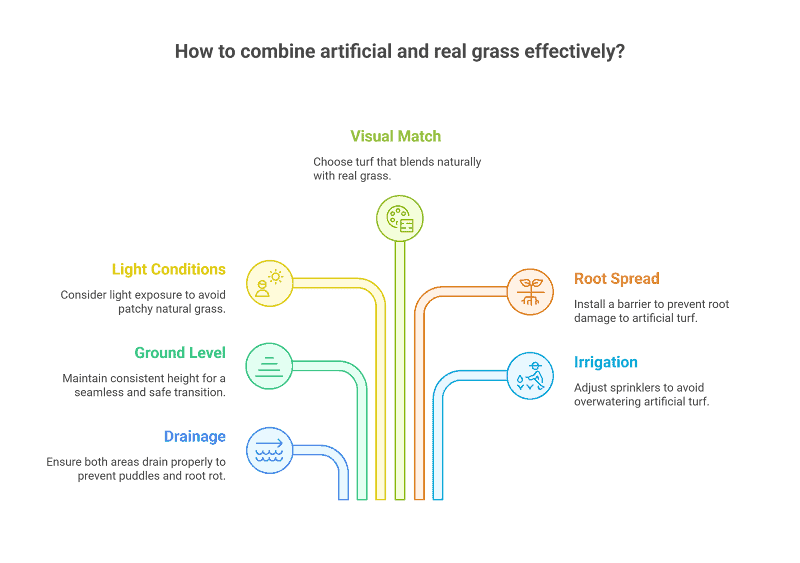
Drainage Needs to Match
Make sure both areas can drain properly. Artificial turf is usually installed with a compacted base that drains differently than soil. Uneven drainage can lead to puddles, root rot, or turf lifting over time.
Ground Level Should Be Consistent
Artificial turf sits on a slightly raised base. If the real grass sits lower or higher, the transition will look awkward and may be unsafe. Always plan to match the height as closely as possible.
Light and Shade Conditions Matter
Artificial turf looks the same in all light, but real grass grows best in sun. Mixing both in shaded areas can make the natural grass look thin or patchy next to a full-looking synthetic patch.
Visual Match Between Surfaces
Choose turf with a color and pile height that blends naturally with your real lawn. A strong visual mismatch will make the mix look artificial, even if the install is perfect.
Root Spread Can Cause Turf Damage
The roots of your real grass can grow sideways into the base of the artificial turf. This may lead to lifting, wrinkles, or weed growth under the turf. Installing a shallow root barrier along the transition edge can prevent this problem.
Check for Irrigation Overlap
If you have a sprinkler system, make sure it doesn’t spray the artificial turf. Too much water on turf can create drainage issues and waste water. You may need to adjust sprinkler heads or zone settings.
How to Install Artificial Grass Next to Real Grass
Installing artificial grass next to real grass takes more than just rolling out a mat. To get a clean, safe, and durable result, you need to follow the right steps — from preparing the base to joining the two surfaces correctly. Below are the key parts of the process you shouldn’t skip.
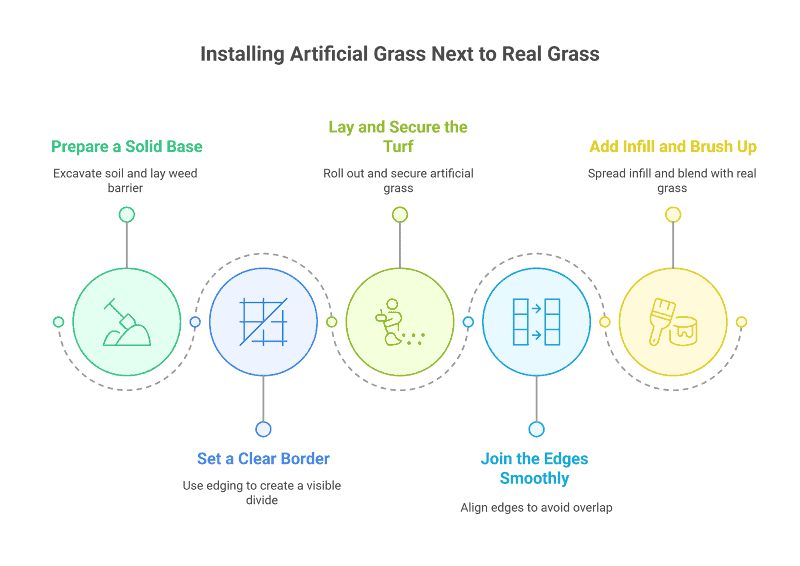
Step 1: Prepare a Solid Base
Excavate about 2–4 inches of soil where the turf will go. Lay down a weed barrier fabric to block future weed growth. Then add a compacted base layer, like crushed stone, to support drainage and prevent sinking or wrinkles over time.
Step 2: Set a Clear Border
Use a bender board, timber, or metal edging to create a visible and physical divide. This keeps the turf in place and separates it cleanly from the live grass.
Step 3: Lay and Secure the Turf
Roll out the artificial grass over the base. Cut to fit and secure with landscaping spikes or adhesive tape, depending on the site. Make sure the pile direction looks natural next to real grass.
Step 4: Join the Edges Smoothly
Leave a narrow gap between the real and fake grass to avoid overlap. Use a joining strip or simply align edges tightly against the divider. Avoid gluing directly to soil.
Step 5: Add Infill and Brush Up
Spread silica sand or rubber infill to hold the turf down and improve durability. Use a stiff broom to brush up the fibers and blend the look with nearby natural lawn.
Can You Lay Artificial Grass Directly on Top of Real Grass?
Technically, yes — but it’s not recommended. Laying artificial grass directly on top of real grass may seem like a shortcut, but it often leads to poor results. The ground underneath will stay soft and uneven, which can cause the turf to shift, wrinkle, or sink over time.
You also risk trapping moisture, inviting mold or pests, and creating drainage problems. In some cases, weeds will continue to grow underneath and push through the turf layer.
If you absolutely have to install it this way (for a short-term event or temporary fix), mow the natural grass as low as possible and lay a weed barrier between the layers. Still, for long-term use, removing the grass and building a proper base is the only way to ensure a clean, stable, and safe result.
Design Ideas for Combining Artificial Grass with Real Grass
When it comes to design, mixing artificial grass with real grass can create a visually balanced and functional space. Whether you’re upgrading a backyard, lining a pool, or creating a pet-friendly zone, thoughtful placement makes all the difference. Here are a few smart ways to combine the two seamlessly.
Backyard Zones with Different Functions
Use artificial grass in areas where real grass wears out easily—like under seating, kids’ play sets, or along high-traffic paths. Let the surrounding lawn remain natural to keep a soft, organic look. This contrast helps define space without using hardscapes.

Poolside Transitions
Real grass near a pool can get muddy and slippery. Try a narrow border of artificial turf right next to the pool deck, with natural grass beyond it. It keeps your feet clean while still preserving a green, resort-like atmosphere.
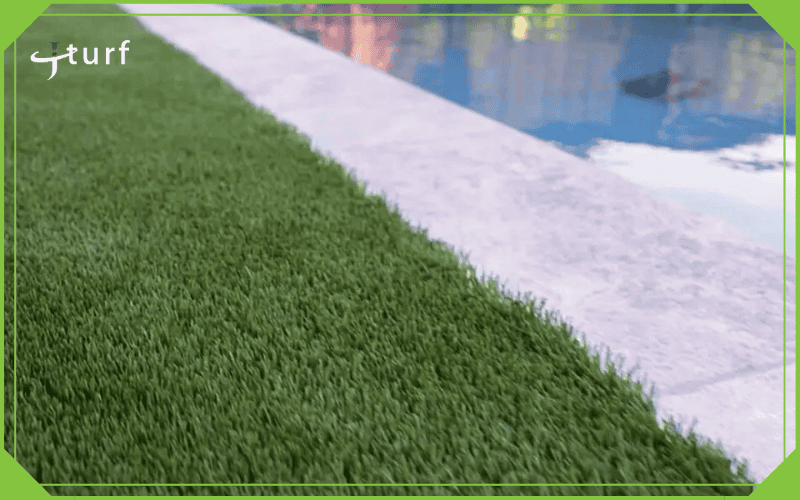
Dog Runs and Pet-Friendly Corners
Artificial grass is ideal for designated pet areas. It’s easy to clean and won’t get patchy from digging or urine. You can edge it with real grass or mulch borders to blend it into the rest of your yard.
Shady Spots or Problem Areas
If certain lawn areas don’t get enough sunlight or drain poorly, switch them to artificial turf. Keep the sunlit parts real. This maintains a lush overall look while solving site-specific issues.
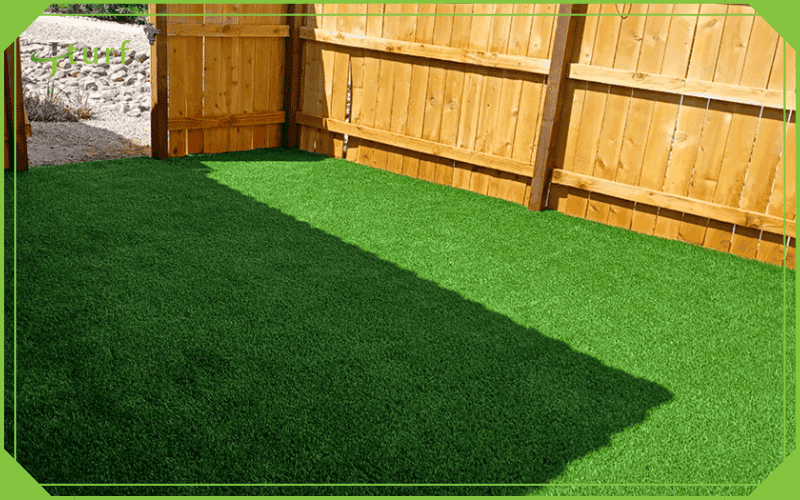
Common Mistakes to Avoid When Mixing Turf and Real Grass
Mixing artificial grass with real grass can look great—if it’s done right. But there are a few common mistakes that can ruin the result or cause problems later. Here are some of the most frequent issues to avoid during planning and installation.
No Separation Border Between Grass Types
Skipping a clear border leads to a messy look and unstable edges. Real grass can creep into the turf area, and the artificial section may shift or fray. Always install a solid edge like timber, metal, or plastic strips to keep both zones clean and defined.
Uneven Surface or Height Difference
If the artificial grass sits higher or lower than the real lawn, the transition will feel awkward and may even pose a tripping risk. Before installation, check that both surfaces will meet evenly, especially after adding the turf base layer.
Choosing Incompatible Grass Styles
Some synthetic turfs look too bright or flat compared to natural grass. This creates a visual mismatch that draws unwanted attention. Pick a turf with a similar pile height and tone to your existing lawn for a more seamless blend.
Poor Drainage Planning
Real grass drains into soil, while artificial turf requires a sub-base to drain correctly. If drainage paths conflict or aren’t planned, water can pool between zones. Ensure both sections have proper runoff and that water doesn’t collect at the seam.
Will Artificial Grass Affect the Real Lawn Nearby?
Artificial grass won’t directly damage your nearby real lawn, but it can affect it in small ways if not installed carefully. The most common issue is heat reflection—turf surfaces can get hot in the sun and radiate warmth onto adjacent grass, causing stress or browning.
Another concern is water overlap. If the real lawn’s irrigation hits both areas, the artificial turf may interfere with drainage or hold excess moisture. In rare cases, roots from the real grass might try to grow under the turf edge.
To prevent problems, leave a small buffer between surfaces, avoid overlapping watering zones, and use edging to separate root systems.
Conclusion
Blending artificial grass with real grass can give you the best of both worlds—beauty and practicality. But success depends on thoughtful planning. Make sure to prepare a proper base, create a clear boundary, and match the surfaces in height and appearance. Avoid shortcuts like laying turf directly on live grass, and take steps to prevent drainage or edging problems.
Done right, this mix can solve common lawn challenges while keeping your outdoor space clean, low-maintenance, and natural-looking. If you’re unsure where to start, focus on function first—then let design follow.

